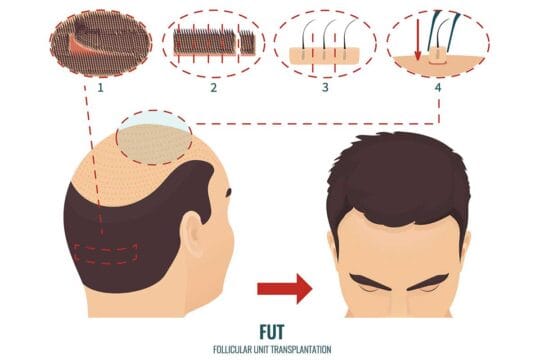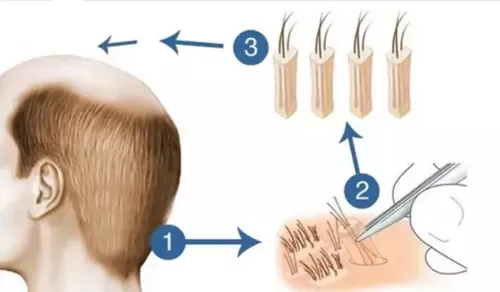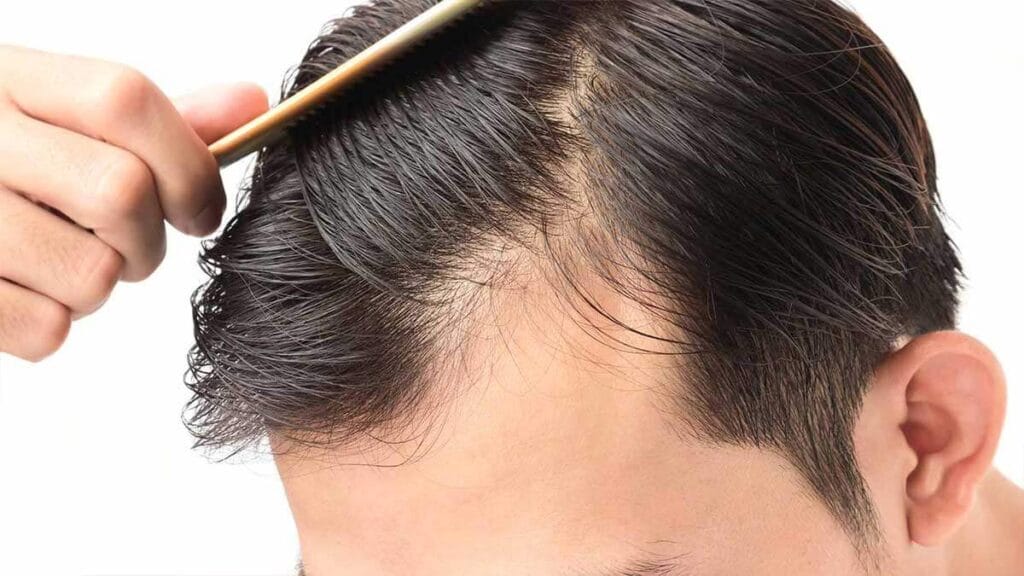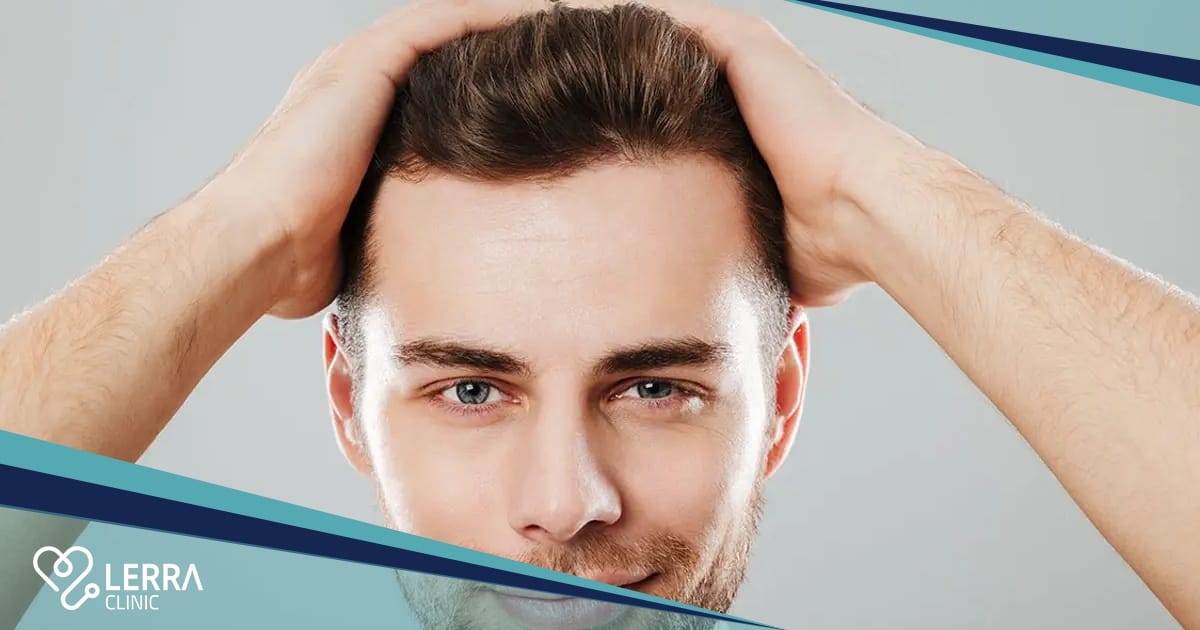Considering a FUT hair transplant in Turkey? Turkey offers affordable costs, high success rates, and expert care. This article explains why Turkey is a top choice for FUT transplants and what you can expect from the procedure.
Table of Contents
Key Takeaways
- Turkey is a prominent destination for FUT hair transplants due to its affordability, skilled specialists, and high patient satisfaction rates.
- The FUT technique involves extracting a strip of scalp tissue for transplantation, allowing for a higher yield of grafts, making it suitable for patients with significant hair loss.
- Post-operative care and proper preparation are crucial for successful recovery, and patients can expect varying timelines for hair growth and healing following the procedure.
Why Choose Turkey for FUT Hair Transplant?
Turkey has emerged as a global hub for hair transplants, particularly FUT hair transplants, thanks to its combination of affordability and high success rates. The country’s healthcare system continually evolves to meet patient needs, ensuring professional and trustworthy services. This has made Turkey, especially cities like Istanbul, an attractive destination for those seeking quality hair restoration procedures.

The cost-effectiveness of undergoing a FUT hair transplant in Turkey is a significant factor drawing international patients. With competitive pricing and comprehensive packages that often include accommodation and transportation, Turkey offers a value proposition that is hard to beat.
Moreover, the expertise of Turkish hair transplant specialists and the state-of-the-art facilities available in the country contribute to the high satisfaction rates among patients who choose Turkey for their hair transplant journey.
Understanding the FUT Technique
Follicular Unit Transplantation (FUT) is a sophisticated hair restoration technique designed to address extensive hair loss using advanced hair transplant techniques.
This method entails:
- Taking a strip of scalp tissue from the donor area, which is typically located at the back of the head, where hair is less likely to bald due to genetics.
- Carefully dissecting the strip into individual follicular units to extract hair follicles.
- Implanting these units into the balding areas of the scalp using direct hair implantation.
One of the primary advantages of the FUT technique is its ability to yield a higher number of grafts in a single session, sometimes reaching up to 4,000 grafts. This makes FUT an ideal choice for individuals with significant hair loss who require a substantial number of grafts to achieve their desired density. The procedure is performed under local anesthesia, ensuring patient comfort throughout the process.
Step-by-Step FUT Procedure in Turkey
Embarking on a FUT hair transplant operation in Turkey involves a detailed and well-coordinated process divided into three main stages: the pre-procedure consultation, the surgical process, and post-procedure care. Each of these stages plays a crucial role in ensuring the success of the hair transplant operations and achieving optimal results.
Let’s delve into each step to give you a clearer picture of what to expect.
Pre-Procedure Consultation
The pre-procedure consultation is a vital first step in the FUT hair transplant process. During this stage, the extent of hair loss is thoroughly evaluated to determine the suitability of the patient for the FUT technique. This assessment allows the medical team to develop a personalized treatment plan tailored to the patient’s specific needs, ensuring the best possible outcomes.
The Surgical Process
The surgical process of a FUT hair transplant begins with preparing the donor area. Typically, this involves shaving the back of the head for easier access and visibility, although candidates preferring longer hair may not need shaving. Local anesthesia is administered to both the donor and recipient areas to ensure a pain-free experience. In some cases, oral or intravenous sedation, or even general anesthesia, may be used.
The core of the procedure involves extracting a strip of scalp from the donor area, which is then dissected into individual follicular units. The units are carefully placed in the areas of the scalp that are balding. This ensures targeted treatment for hair restoration. The entire process typically takes six to eight hours to complete.
After the surgery, patients are advised to rest and follow up the next day for a check-up.
Post-Procedure Care
Post-procedure care is crucial for supporting optimal healing and ensuring the success of the FUT hair transplant. Patients receive specific aftercare instructions to maintain proper scalp care and promote healing. Since the donor area remains unshaven, the scabs formed during healing are less visible, which is advantageous for patients who prefer longer hairstyles.
Consistent follow-up visits to the clinic are essential to monitor the healing process and address any potential issues promptly. Proper post-procedure care, including avoiding strenuous activities and following the clinic’s instructions, is vital for achieving the best possible results from the FUT hair transplant.
Comparing FUT with Other Hair Transplant Methods
When comparing FUT with other hair transplant methods such as FUE and DHI, several factors come into play. One notable advantage of FUT is its higher graft yield in a single session, making it suitable for patients with extensive hair loss.
However, patients concerned about visible scarring often prefer FUE or DHI hair transplant, as these methods result in minimal scarring. DHI, in particular, offers enhanced control over the implantation process, potentially leading to more natural growth patterns.
FUE variations like Sapphire FUE utilize specialized tools for more precise incisions, which can reduce healing time. While FUT is generally more affordable compared to FUE and its variations, patient preferences often gravitate towards methods that promise less discomfort and faster recovery.
Ultimately, the choice of technique depends on individual needs and priorities.
Cost of FUT Hair Transplant in Turkey
The cost of FUT hair transplants in Turkey is a significant factor that attracts many international patients. The price range typically starts from around €1,000 and can reach up to €3,000. On average, the fut hair transplant cost ranges from €923 to €2,012, making it a cost-effective option compared to other countries.
Turkish clinics often provide all-inclusive packages, simplifying the financial aspect for patients.
Factors Affecting Cost
The cost of FUT hair transplants in Turkey is influenced by several factors. These variables can affect the overall price:
- The experience of the surgeon, as more experienced surgeons may charge higher fees.
- The extent of hair loss, which can impact the overall cost.
- The complexity of the procedure, which can also affect pricing.
Understanding these factors can help you make an informed decision when considering a hair transplant.
Additionally, the specific technique used for the transplant plays a role in determining the final price.
FUT Hair Transplant in Turkey with LerraClinic

Turkey is globally recognized for its excellence in hair transplantation, and LerraClinic stands out as a trusted destination for advanced FUT (Follicular Unit Transplantation) procedures.
At LerraClinic, we combine medical expertise with personalized care to deliver natural-looking, long-lasting results. Our team of experienced surgeons utilizes the latest techniques to extract and dissect follicular units with precision, ensuring high graft survival rates and minimal scarring.
Each patient receives a customized treatment plan based on a thorough evaluation, including scalp analysis and long-term hair restoration goals. We also provide lifetime guarantees on results, complimentary consultations, and treatment in a fully accredited medical facility.
Whether you’re just beginning to explore hair restoration or are ready to move forward, LerraClinic is committed to guiding you through a safe and satisfying transformation.
Success Rates and Longevity of FUT Hair Transplants
The success rates and longevity of FUT hair transplants are generally high, with many patients reporting satisfactory results. In a study, 81.25% of patients reported good results one year after the procedure. However, hair density can moderately reduce over time, with 55.35% of subjects showing moderate loss after four years. The longevity of transplanted hair follicles may be influenced by factors such as blood supply and skin thickness.
Patients often experience lower chances of hair loss with FUT grafts since they are harvested from the Safe Donor Area, which is genetically resistant to balding. While some reduction in hair density is expected over time, many patients enjoy long-term benefits and a significant improvement in their overall hair appearance.
Potential Side Effects and Precautions
Understanding the potential side effects and necessary precautions associated with FUT hair transplants is crucial for ensuring a safe procedure and enhancing patient confidence. Common side effects include tightness, soreness, and swelling of the scalp for several days post-surgery. Temporary scabbing may also occur in the areas where hair has been transplanted.
Patients should avoid taking blood-thinning medications like aspirin and ibuprofen prior to the procedure to minimize bleeding risks. Ceasing smoking at least one week before the operation is also advisable to promote better recovery outcomes.
Post-operative care instructions typically include avoiding exercise for a month to help minimize scarring and support the healing process.
Ideal Candidates for FUT Hair Transplant
Ideal candidates for FUT hair transplants are individuals experiencing significant hair loss, including those with advanced hair loss and male or female pattern baldness. Candidates should also have sufficient donor hair to ensure a successful transplant. The minimum age for a hair transplant is 18 years, and the maximum age for eligibility is 59 years.
Those who meet the age requirements and have extensive hair loss, along with sufficient donor hair, are the best candidates for FUT hair transplants. By meeting these criteria, candidates can achieve optimal results from their hair restoration procedure.
Preparing for Your FUT Hair Transplant
Preparing for a FUT hair transplant involves several important steps to ensure a smooth and successful procedure. Consulting a qualified surgeon is essential to determine the suitability of the FUT method for your specific case. During the consultation, the surgeon will review your medical history and conduct a personal examination to provide tailored instructions on surgery suitability. Patients are advised to stop smoking and consuming alcohol at least one week before surgery to promote better healing outcomes.
On the day of the surgery, the back of the head is typically shaved to prepare for the transplant site. It is also important to wash your hair with a mild shampoo to ensure cleanliness. Maintaining a balanced diet rich in nutrients and staying well-hydrated in the days leading up to the surgery can facilitate better healing and overall success of the transplant.
Recovery Timeline and Expectations
The recovery timeline for a FUT hair transplant involves several stages, each with its own set of expectations and care instructions. Patients can expect initial symptoms such as swelling, redness, and mild discomfort within the first two weeks. The healing process is gradual, with initial results becoming visible after a few months post-surgery.
Following post-operative care instructions diligently is crucial for optimal healing and achieving the best possible outcomes.
First Two Weeks
During the first two weeks of recovery, patients may experience some swelling and discomfort in the donor and recipient areas. Itchiness and scabs falling off are also common as the scalp begins to heal. Avoiding strenuous activities and scratching the scalp is essential to promote healing and prevent complications.
Following these care instructions during the recovery period is crucial for achieving good outcomes from the FUT hair transplant.
One Month Post-Surgery
Typically, patients observe early signs of hair growth in the transplanted area by one month after surgery. This marks an encouraging step in the recovery process. The new hair may appear thin and sparse at this stage, but this is a normal part of the healing process. Follow-up appointments with the clinic are important to assess progress and address any concerns.
Older individuals often show better healing with minimal scarring due to improved recovery processes with age.
Three Months Post-Surgery
Three months post-surgery marks a critical stage in the recovery process, as many patients begin to see new hair growth. The transplanted hair typically starts to thicken and establish itself in the scalp. Although the new hair may initially appear fine and less robust, noticeable improvement in hair density is usually evident by this stage.
Regular follow-up appointments with the surgeon are essential to monitor progress and ensure the best possible outcomes.
Expert Tips for Maintaining Transplanted Hair

Maintaining transplanted hair requires a combination of proper care and a healthy lifestyle. A diet rich in vitamins and minerals is essential for supporting the growth of transplanted hair. Nutrients such as biotin, zinc, and vitamins A, C, and E play a crucial role in promoting hair health and growth. Hydration is equally important; drinking plenty of water helps improve blood circulation to the scalp, which is vital for healthy hair growth.
In addition to a balanced diet, gentle hair care practices are crucial. Using a sulfate-free shampoo and avoiding harsh hair products can prevent irritation and damage to the scalp. Applying natural oils like argan or coconut oil can nourish the scalp and aid in the healing process.
Regularly trimming the hair and avoiding excessive use of styling tools can also help maintain the health and appearance of the transplanted hair.
Patient Testimonials and Before & After Photos
Patient testimonials and before-and-after photos provide valuable insights into the effectiveness of FUT hair transplants. Many patients express satisfaction with the speed and comfort of the procedure, noting minimal discomfort during recovery. Testimonials often highlight the convenience and quality of service received during their hair transplant experience. The restored hair density and natural appearance achieved through FUT transplants are frequently praised.
Before-and-after galleries showcase authentic transformations of numerous individuals who have undergone successful FUT hair transplants. These visual results demonstrate the significant improvements in hair density and overall appearance, boosting patients’ confidence and providing a youthful look. Such testimonials and photos serve as powerful motivators for those considering a FUT hair transplant.
Summary
In summary, FUT hair transplants offer a reliable and effective solution for individuals experiencing significant hair loss. Turkey has emerged as a leading destination for this procedure, thanks to its combination of affordability, high success rates, and advanced medical practices. The FUT technique involves extracting a strip of scalp tissue, which is then dissected into individual follicular units and transplanted into balding areas, providing higher graft yields in a single session.
Understanding the entire process, from pre-procedure consultation to post-procedure care, is crucial for achieving optimal results. By following expert tips for maintaining transplanted hair and considering patient testimonials, individuals can make informed decisions about their hair restoration journey. With the right preparation and care, a FUT hair transplant can lead to long-lasting, natural-looking results, enhancing both appearance and confidence.
Contact us today and get the best offer!
Read Also:
The Best All-Inclusive Hair Transplant Turkey Packages
Frequently Asked Questions
Why is Turkey a popular destination for FUT hair transplants?
Turkey is a popular destination for FUT hair transplants due to its affordable costs, high success rates, and the presence of reputable clinics. This combination makes it an appealing choice for those seeking effective hair restoration solutions.
What does the FUT hair transplant technique involve?
The FUT hair transplant technique involves excising a strip of scalp tissue, which is then meticulously divided into follicular units for transplantation into areas experiencing hair loss. This method ensures that dense groups of hair follicles are effectively restored in balding regions.
How much does a FUT hair transplant cost in Turkey?
The cost of a FUT hair transplant in Turkey generally ranges from €1,000 to €3,000, with an average price around €1,500. This makes it a financially viable option for many seeking hair restoration.
What are the potential side effects of a FUT hair transplant?
Common side effects of a FUT hair transplant include tightness, soreness, scalp swelling, and temporary scabbing in the transplanted areas. It is important to discuss these potential effects with your healthcare provider.
Who are ideal candidates for a FUT hair transplant?
Ideal candidates for a FUT hair transplant are those experiencing significant hair loss, particularly in the advanced stages, who also possess adequate donor hair, and typically fall within the age range of 18 to 59 years.

